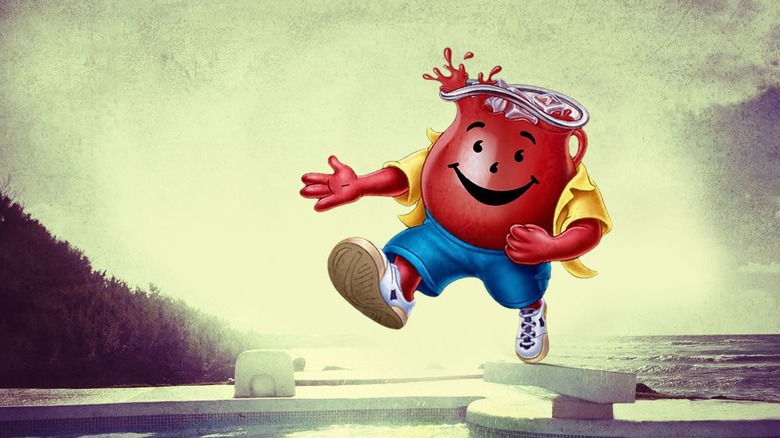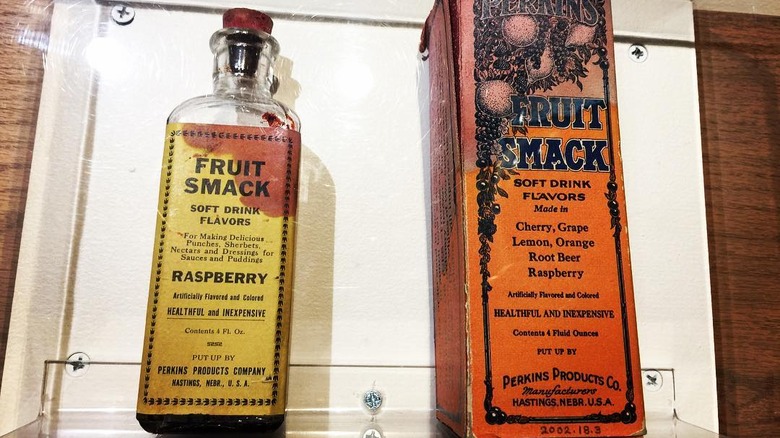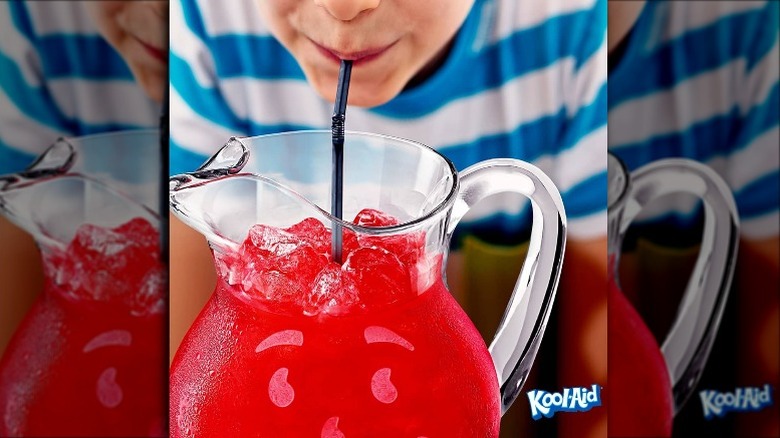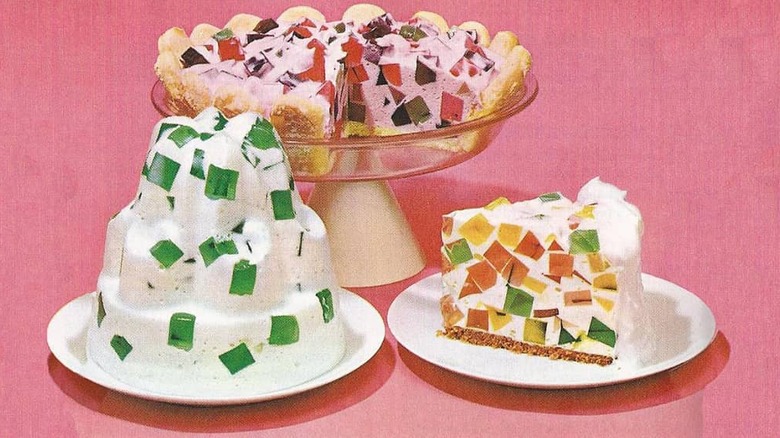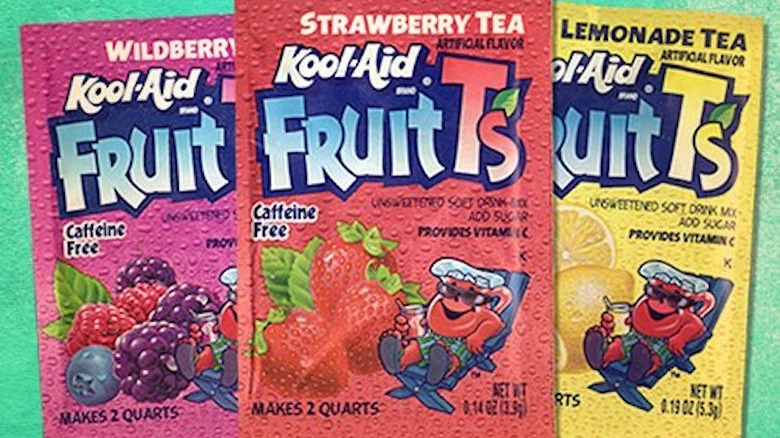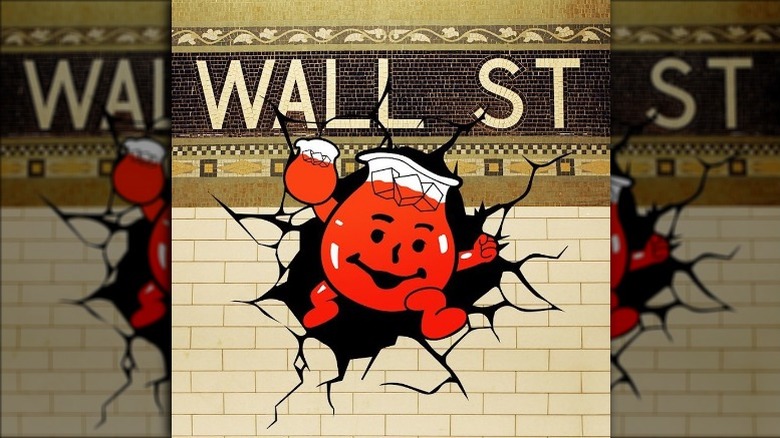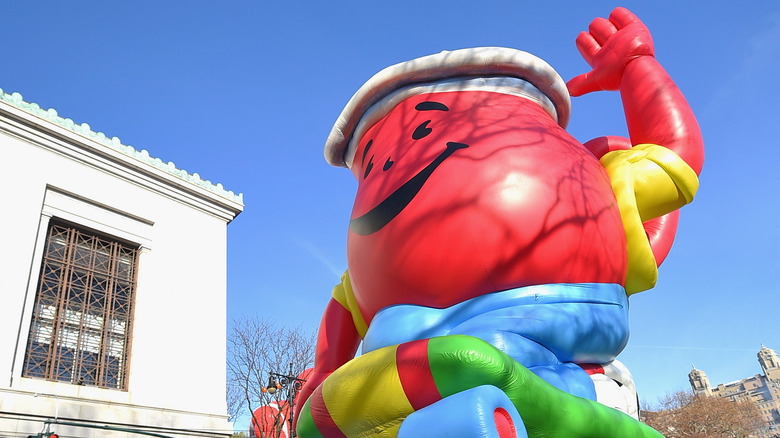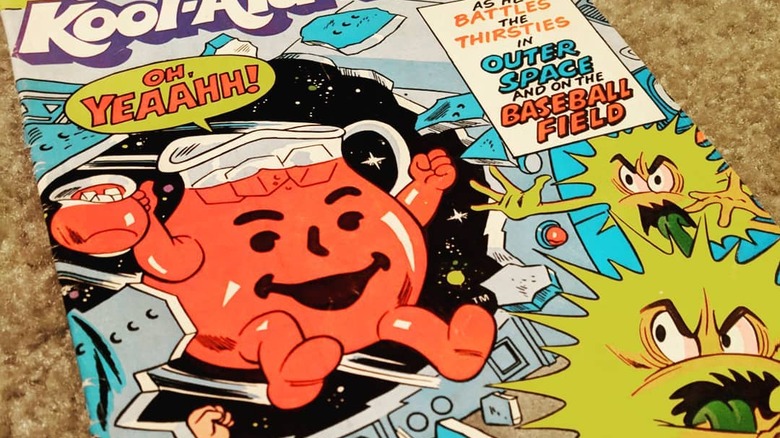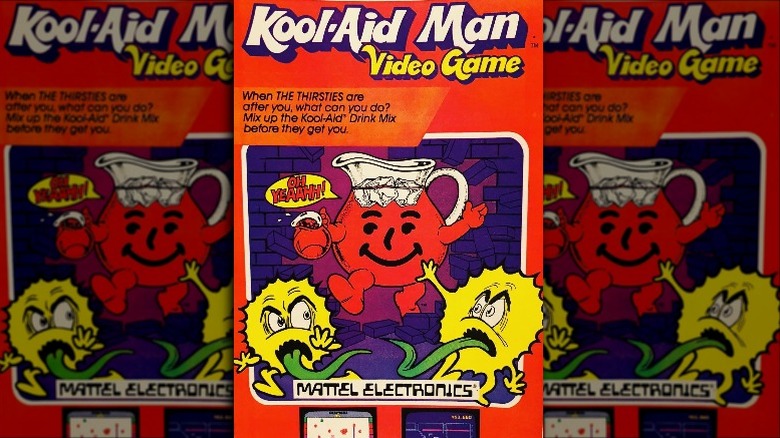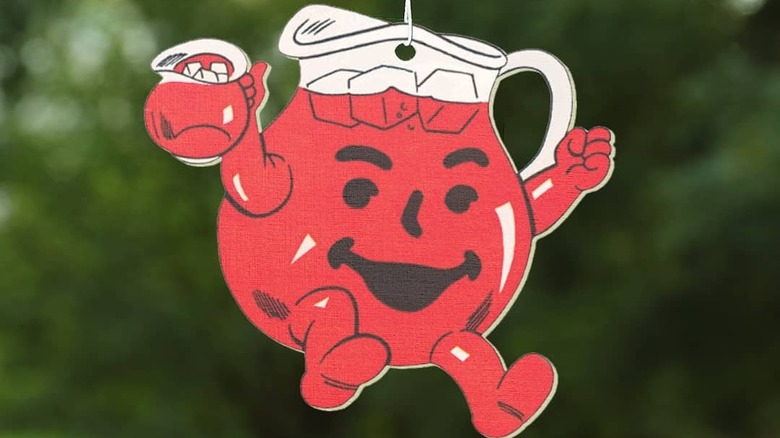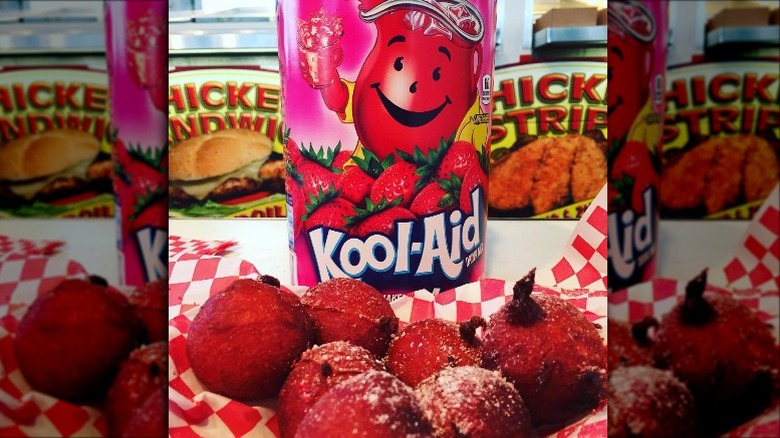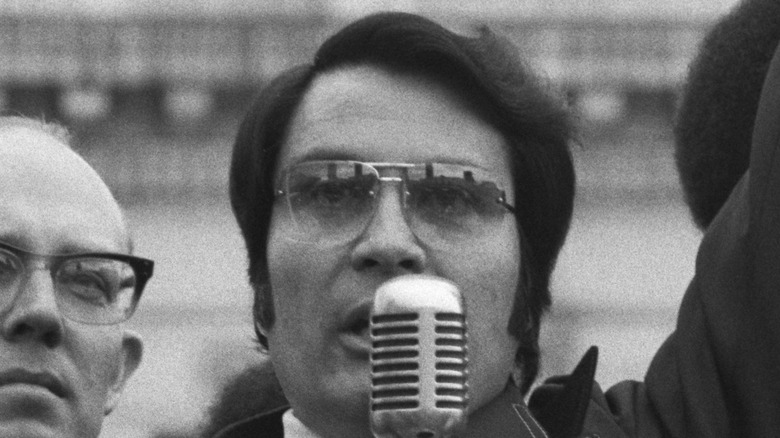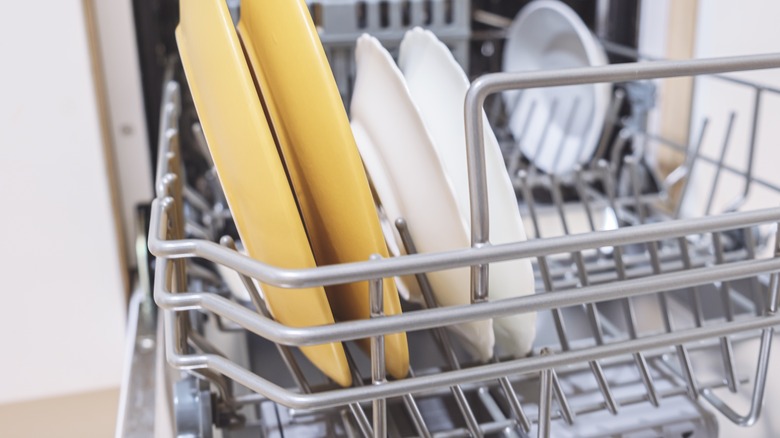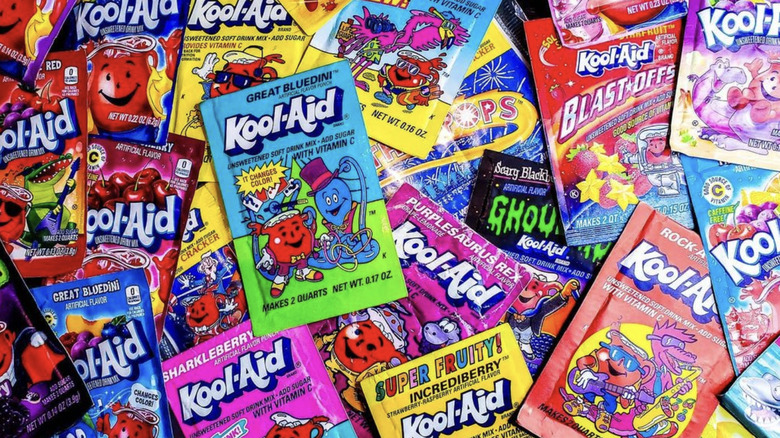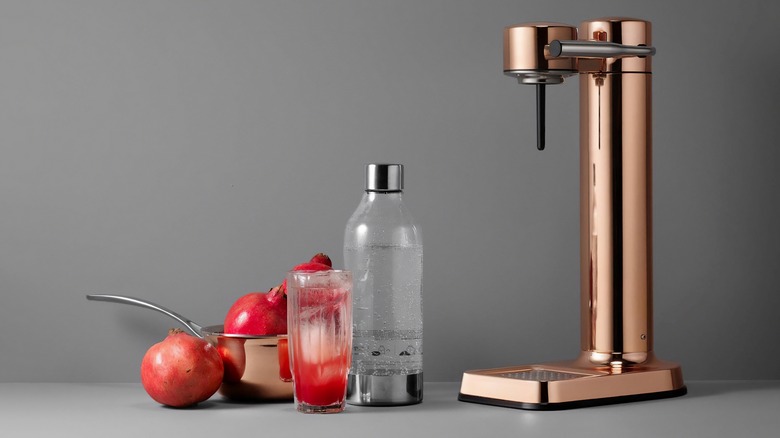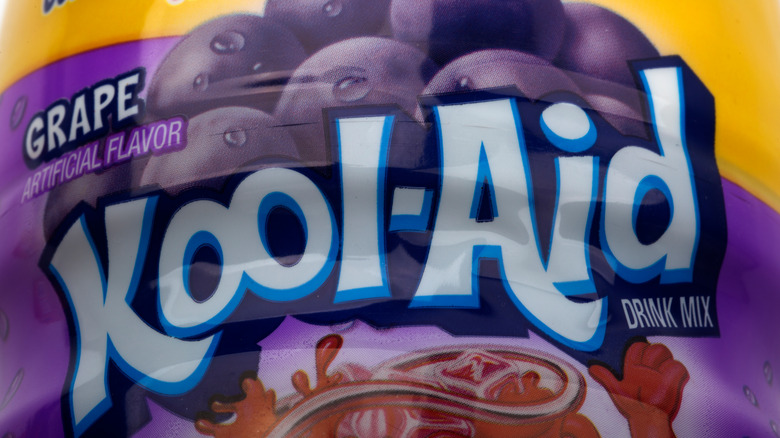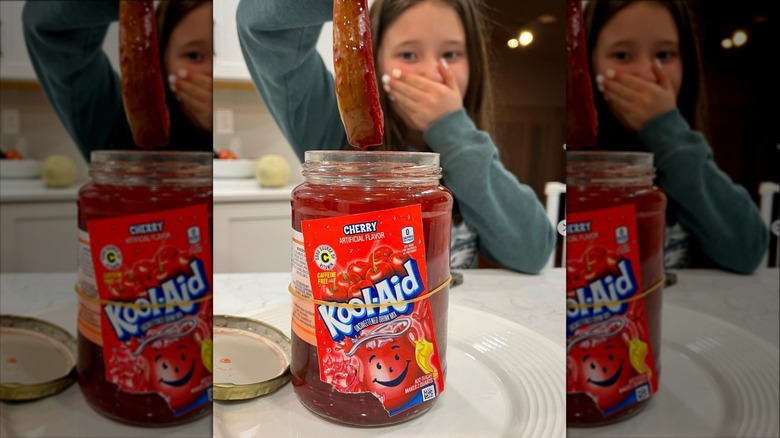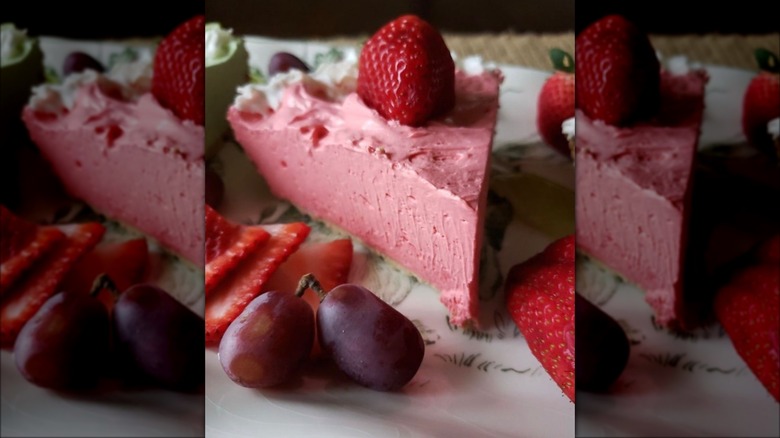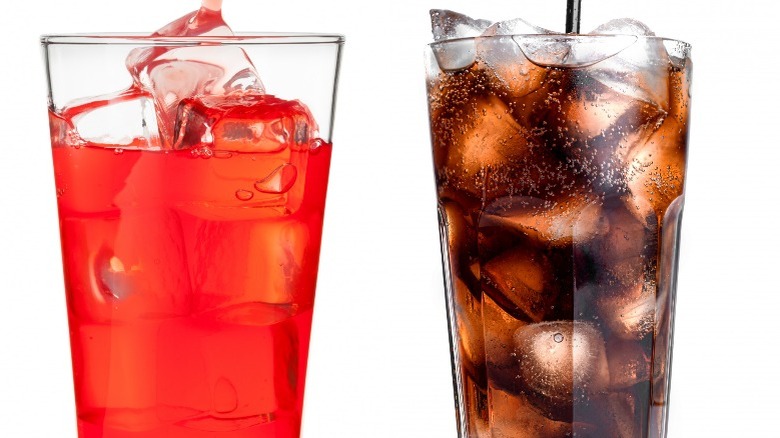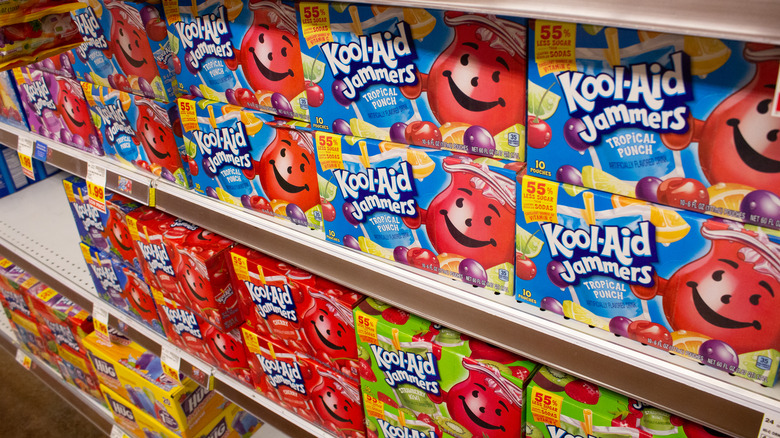Kool-Aid: 19 Facts About The Popular Drink
We can still remember the way Kool-Aid was prepared when we were kids: You needed a gigantic translucent pitcher, its edges roughly chewed away by the dishwasher, a paper packet decorated with cartoon characters and containing just a few crystallized grams of brightly-colored Kool-Aid drink mix, and all of the granulated sugar your mom had in the house.
In those days, there were only a few different flavors of Kool-Aid available, but it wasn't an issue because "Red" was the only color that mattered. Our refined grammar school palates paired a big glass of Kool-Aid with a bologna and cheese sandwich (crusts cut off, please), or one of the other popular after school snacks of the day, such as Handi-Snacks or that newfangled chip called Cool Ranch Doritos. It hardly mattered what you ate because you knew that when you got to have Kool-Aid, it was basically your parents giving you license to drink 8 fluid ounces of unadulterated toddler rocket fuel, and you couldn't be held responsible for anything that happened afterward.
How did a humble businessman take a magical, fruit-flavored tonic that was originally sold through the mail for pennies, and turn it into a global brand that spawned two video games and a short-lived comic book series, while fueling the dreams of an entire generation of tiny champions? Join us as we dive through the pages of history to learn the untold truth of Kool-Aid.
It wasn't always called Kool-Aid
The Kool-Aid name is a friendly, harmless moniker that reflects the lighthearted deliciousness of the drink itself. But what if we told you that the sugary beverage was once marketed under a much different, more vaguely threatening name?
Edwin Perkins, the inventor of Kool-Aid, grew a business selling smoking cessation products door-to-door into a massive company that eventually sold over 125 household products using direct sales.
But it wasn't until Perkins' sales force added a summer soft drink concentrate called "Fruit Smack" to the product lineup that customers began to sit up and take notice. Coca-Cola was quickly catching on as the nation's sugary soda of choice, but Fruit Smack allowed families to make an entire pitcher of the drink for just pennies.
Perkins set to work on some of the product's marketing shortcomings, starting with the name. The company trademarked the name "Kool-Ade" in 1927, and it was changed to "Kool-Aid" a few years later. The reason for the change depends on who you ask; while many different stories circulate among the members of the Perkins family, the likeliest explanation is that government regulations prevented the company from using "Ade" (as in, "lemonade" or "limeade") in a product that didn't contain any fruit juice. Whatever the reason, "Kool-Aid" seemed to stick, and the product name hasn't changed again since.
It was first sold as a liquid drink mix
As successful as Fruit Smack was shaping up to be for Perkins Products, it had one major shortcoming that would need to be addressed before sales could take off and the product could be sold nationwide.
The fruit-flavored drink that would eventually become Kool-Aid was initially sold as a liquid concentrate in 4-ounce, corked glass bottles. While the concentrate was convenient, shipping it presented a real problem; the bottles were expensive to produce, costly to ship, and had an unfortunate tendency to break or leak brightly-colored syrup all over everything. Inventor Edwin Perkins knew that it would have to be converted into a powdered form, which could be sold in an inexpensive paper envelope, in order to make distribution easier.
Though he would later protest that he was "not a chemist," Perkins and his assistants set to work figuring out how to dehydrate the recipe for the fruit concentrate, by noodling with the ratios of dextrose, citric acid, tartaric acid, flavoring, and food coloring. By 1927, the formula was perfected, and the light, easy-to-package and ship product we know as "Kool-Aid" was born.
With this powdered concentrate, he could distribute small, nearly indestructible packets of his new drink mix to wholesale grocery and candy stores, and was eventually able to sell nationwide through food brokers. The packets sold for 10 cents apiece, and provided enough mix for a family to make a whole pitcher of Kool-Aid.
Its invention was inspired in part by Jell-O
If there was one family of products that Edwin Perkins was positively starry-eyed over, it was Jell-O.
Perkins was first introduced to the wonderfully wiggly stuff as a child at the age of 11, way back in the year 1900. A powder that transformed first into a liquid, and then into a mysterious solid, available in six fruity flavors, would turn into a lifelong obsession that would impact everything from the way Perkins hyphenated all of his product names (including Nix-O-Tine, Motor-Vigor, Glos-Comb, Jel-Aid, and E-Z-Wash) to the way Kool-Aid would eventually be packaged, sold, and marketed.
When trying to figure out how to ship his flavor concentrates nationwide without the cost of breaking bottles, Perkins probably turned to his childhood memories of Jell-O for inspiration. He knew that reducing bold, fruity flavors to powdered form was possible, and he had already mastered the use of powdered fruit pectins for his "Jel-Aid" jelly-making product. Tweaking the Fruit Smack formula to eventually become Kool-Aid was just a matter of time and experimentation... but thanks to Jell-O, he knew from the start that it was possible.
In a fitting twist of fate, Perkins Products was taken over by General Foods in May 1953, which was also the parent company of his beloved Jell-O. It was, apparently, meant to be from the beginning.
There were originally just six flavors
When America's favorite sugary powdered drink mix got its start, there wasn't the vast array of mouth-tickling flavors available that we've grown accustomed to. In fact, Kool-Aid was initially produced in just six original flavors: grape, lemon-lime, cherry, orange, raspberry, and strawberry.
Fast forward to the year 2019, and Kool-Aid powder is sold in a dizzying rainbow of over 20 flavors, including Lemonade, Pineapple, Mango, Green Apple, Strawberry Kiwi, Blue Raspberry, and something called "Sharkleberry Fin," a sort of orange-strawberry flavor that also happens to be one of the only varieties of Kool-Aid that contains banana flavoring. And that doesn't even include the forgotten varieties from Kool-Aid's storied history of palate-pounding flavor hysterics, including Rock-a-Dile Red (a generic fruit punch enhanced by a saxophone-playing crocodile on the package), Purplesaurus Rex (a grape-lemonade hybrid), Great Bluedini (a punch that changed color), Incrediberry (a strawberry-raspberry combo), Pink Swimmingo (a "SUPER FRUITY!" combination of watermelon and cherry), and Berry Blue (a blue raspberry lemonade that mimicked the shade of windshield wiper fluid exactly).
The Great Depression may have helped make it a household name
You don't often hear about the success stories that came out of the Great Depression; mostly, we tend to think of our great-great-grandparents selling pencils on street corners, eating boiled potatoes from a battered tin bowl at the local soup kitchen, or falling tragically to their deaths while constructing gigantic gravity-defying government engineering projects.
But it's precisely this catastrophic economic downturn and grim national mood that may have helped transform Kool-Aid into a household name. While banks all over the country were closing their doors and layoffs were rampant, Perkins Products saw a marketing opportunity; they slashed the price of a packet of Kool-Aid from 10 cents to 5 cents, and aggressively marketed the product with the message that you could produce a whole pitcher of their sweet, refreshing drink for the same price as a single bottle of Coca-Cola. Even with the majority of Americans facing the dim economic prospects of the Great Depression, most families still had a nickel to spend, particularly on such a bargain-priced beverage, and sales figures exploded. In a 1956 article in Advertising Age (via Adams County Historical Society), the price cut was described as "a daring gamble that made the company," and increased sales from $383,286 in 1931, to $1,564,292 just five years later.
It's the official soft drink of this state
Kool-Aid inventor Edwin Perkins may have been born in Iowa, but it was his family's move to rural Nebraska that firmly rooted the drink's invention to the city of Hastings. Each year, the town celebrates with a three day festival honoring the Perkins family and the invention that helped put Hastings on the map with a parade, special events including a bicycle race, Frisbee golf tournament, live music, fireworks, Kool-Aid chugging contests, and cardboard boat races, all culminating in the coronation of "Miss Kool-Aid Days."
Enthusiasm for the beverage extends well beyond Kool-Aid's birthplace in Hastings; the small town of Hendley, Nebraska lays claim to making a major contribution to the birth of Kool-Aid, since that's where a young Edwin Perkins first began his entrepreneurial journey while at work in a store there as a child. The drink is even celebrated on a statewide level; Nebraska designated Kool-Aid as "the official state soft drink" in 1998, which is a thing that apparently states have. (Lest you think that Nebraska is only promoting the consumption of neon-colored, high-sugar drinks, you can rest easy knowing that its other official state beverage is milk, a nod to the importance of its dairy industry.)
Kool-Aid Man didn't appear until the 1970s
The most popular anthropomorphized drink pitcher of all time didn't appear until 1975, and was an extension of a concept invented about 20 years earlier called Pitcher Man: a bulbous container of Kool-Aid with an animated mouth and eyes. According to company legend, inventor Edwin Perkins drew the inspiration for Pitcher Man from the smiley face his child drew on the condensation of a window.
Pitcher Man was back-burnered throughout most of the 1960s, with the company marketing their project with celebrity spokespeople like The Monkees and Bugs Bunny, until the idea was revisited in 1975. According to Mental Floss, the evolution from Pitcher Man to Kool-Aid Man meant that though the face would no longer be animated, but "the addition of arms and legs gave the character a more bombastic personality. It also allowed him to commit sensational acts of property destruction."
But Kool-Aid Man's signature wall-smashing entrance happened almost entirely by accident. According to Robert Skollar, who was hired to oversee marketing in the 1980s, the sequence wasn't exactly planned. "Someone on set said that Kool-Aid Man really had to make an entrance, and someone else suggested he come through the wall," he said. Breakaway bricks were set up, turning the character's fiberglass shell into a wrecking ball, and cementing Kool-Aid Man's permanent place in pop culture history.
Kool-Aid Man was so popular he got his own video game
If you weren't around in the 1980s, it may be difficult to understand just how firmly rooted Kool-Aid Man was in the national consciousness, with his frenetic, flamboyant personality and his near total disregard for private property laws.
Kool-Aid Man was everywhere, and for a time, was arguably more recognizable and ubiquitous than fellow contemporaries Tony the Tiger or Ronald McDonald. The character became so popular, Marvel even produced a limited run of comic books, titled The Adventures of Kool-Aid Man, which ran for three issues back in 1983.
The irreverent character also starred in not one, but two video games, for the Intellivision and Atari 2600, the latter of which "could be redeemed with 125 points earned from purchasing Kool-Aid, which amounts to about 62.5 gallons of sugar water," according to Mental Floss.
Though the games were by no means "innovative" or "fun," even when measured by early-1980s gaming standards (and if you don't believe us, try playing the online version of the Atari 2600 title), the obvious marketing tie-in does speak to the overwhelming popularity of the mascot at the time.
Kool-Aid Man hasn't changed much through the years
It's not unusual for popular food mascots to evolve and change over the years. Even the most popular characters, from Ronald McDonald to whatever that leprechaun's name is who shills for Lucky Charms, need a little freshening up from time to time. But not Kool-Aid Man; he's stayed remarkably similar since 1975.
Early incarnations of Kool-Aid Man featured simpler renderings of a pantsless, smiling, anthropomorphized pitcher with three ice cubes for brains crashing through walls to rescue children from boredom. The first major change to the Kool-Aid Man persona came in the early 1980s, when his age, which previous marketing campaigns had implied to be about 7 years old, abruptly got bumped up to age 14. Suddenly, Kool-Aid Man was old enough to play guitar and surf, all while wearing jeans, sunglasses, sneakers, and cool shirts.
The next major update to Kool-Aid Man didn't come until 2013, well after the completely bonkers television commercial heyday of the 1980s. That's when Kool-Aid Man made the leap from a live-action fiberglass costume to a fully computerized 3-D rendering. According to Milwaukee Magazine, the change meant that Kool-Aid Man would "be less about breaking through brick walls and shouting 'Oh yeah!' and more about making friends. Using the latest 3-D technology, Kraft has simulated a dewy coating of condensation on the Man's exterior, making him appear more fragile — and lifelike — than he has in past decades."
You can deep fry it
After you've guzzled a few quarts of the iconic sugar water, used it to dye your hair, or scoured your toilet bowl with it, what's left to do with Kool-Aid? Why, you throw it in a deep fryer, cross your fingers, and hope for the best, of course.
According to the NY Daily News, deep-fried Kool-Aid is the invention of fair food chef Charlie "Chicken" Boghosian, who is also responsible for deep-fried Klondike Bars, Girl Scout Thin Mints cookies, and Pop Tarts.
"Deep-fried Kool-Aid in its finished form is like a pastry, first sweet and then tangy, according to delighted tasters," the Daily News explained. "The recipe is top secret but it involves a whole lot of Kool-Aid powder, flour, powdered sugar, and hot oil."
If you think that sounds more like a Kool-Aid flavored donut, you're not alone. One taster described the crispy Kool-Aid as "more like a doughnut than Kool-Aid," with another taster saying that the fair frankenfood was more reminiscent of a "New Orleans Hushpuppy with Kool-Aid flavor."
'Drinking the Kool-Aid' isn't historically accurate
Kool-Aid is a victim of its own success. According to Consumer Reports, some products become so popular and iconic over such a long period of time that their trademarked brand name becomes synonymous with the thing itself. As a result of this phenomenon, Kool-Aid, produced and mass-consumed since the 1920s, doesn't necessarily refer to the name-brand Kool-Aid distributed by Kraft Foods. For some, if may also refer to any of the powder's competitors, such as Wyler's or Flavor Aid.
The cultural dominance of Kool-Aid even plays a part in a mass tragedy. According to Forbes, the phrase "drinking the Kool-Aid," means to blindly follow an individual or ideology to one's doom or detriment. In November 1978, Peoples Temple leader Jim Jones led his adherents to take their own lives at his Jonestown compound in Guyana, according to the FBI. Fearing his whole operation was about to end, Jones took his own life with a self-inflicted gunshot wound while his followers were instructed to kill themselves by drinking a fruit drink mix that had been laced with a fatal amount of cyanide. More than 900 people died, many by literally "drinking the Kool-Aid." But the Jonestown deceased didn't technically consume Kool-Aid — the mix on hand was cheaper Flavor Aid.
You can clean your dishwasher with Kool-Aid
With its images of kids with red-stained lips and full glasses spilled on carpets, "clean" isn't the first word most people would immediately associate with Kool-Aid. However, the drink mix in its purest form — dry, powdered and crystalized, right out of the packet — can be used to clean two major household appliances. That is, provided you use the right flavors with the least intense staining agents.
While lemons are a well-known and powerful cleaning tool, the most prominent ingredient in unsweetened lemonade-flavored Kool-Aid isn't actual lemons, but citric acid, a compound found in the fruit. According to HuffPost, citric acid is a major weapon against filth. Meanwhile, the lack of sugar or strongly-colored dyes in the lemonade flavor keep you from making a sticky mess. This Kool-Aid is ideal for cleaning a dishwasher plagued by built-up lime deposits. Here's how to do it: With a fully empty dishwasher, pour an envelope of the no-sugar-added lemon Kool-Aid into the detergent slot, then run any cycle. The citric acid and hot water will help to melt away the unwanted grime.
You can make some serious cash by selling old Kool-Aid packets
Seemingly anything nonperishable that can be produced, bought, sold, and preserved can eventually be a collectible. And because some everyday objects simply don't last — either due to rot, use, or simply being thrown away — the items that stay intact can be worth a lot of money to collectors. Some people are willing to pay top prices for these rare relics of the past.
Even Kool-Aid packets or containers that are especially rare, limited-edition, discontinued, or widely-forgotten specimens can fetch huge sums in collectors' circles and on the secondary market. A 34-ounce, unopened canister of lemonade Kool-Aid dating to 1975 sold for $140 on eBay in 2022. Meanwhile, a lot of the not-rare but fondly-remembered (per Dinosaur Dracula) Rainbow Punch from the 1980s pulled in $150. A box of five "Great Bluedini" Kool-Aid packs from the '90s fetched $90 on eBay in 2022 and a single, rare Tropical Punch Kool-Aid, distributed only to Bob Evans restaurants in the 1990s, sold for just under $75. Maybe it's time to check your pantry.
You can make Kool-Aid with your SodaStream
For decades, Kool-Aid was easy to prepare the exact same way, time after time: A packet or spoonful was mixed into water, with sweetener added to taste as necessary. In 2012, according to the Chicago Tribune, Kraft Foods brokered a deal to bring Kool-Aid formulas to the increasingly popular world of SodaStream, the line of home appliances that carbonate plain old water with the push of a button and a gas cartridge. At long last, Kool-Aid could be bubbly.
After finding success licensing out other drink mixes for use as concentrated SodaStream flavoring agents, such as Crystal Light and Country Time, Kraft was ready to let the carbonation purveyors have access to its flagship powdered drink brand. The move immediately triggered a sizable rise in Kraft's stock price, in advance of Kool-Aid flavors hitting SodaStream sections of home goods and grocery stores in late 2012.
Is Kool-Aid vegan?
It's hard to know exactly what's in a packaged, processed, shelf-stable food, particularly if it's created in a factory and crushed down into a slightly colored, extra-sweetened powder — as is the case with Kool-Aid. Even checking the label for ingredients can be a frustrating experience, as that list is often less than forthcoming. It's hard to know the exact chemical makeup or production history of each and every item in the food. For these reasons, vegans may have a hard time finding out if the food they want to eat adheres to their diet. Kool-Aid seems like a pretty good choice — it tastes like fruit juice, looks like real fruit juice, and is mostly sugar. So, many assume that it's not made with meat, or commonly used animal products like eggs, whey, or honey.
Kool-Aid's line of products isn't necessarily vegan-friendly, however. According to Vegan Decoder, the sugar in Kool-Aid could be problematic. U.S.-based sugar processors commonly refine and filter sugar with bone char, which is made from the ground up and burnt skeletons of animals. Sugar-free Kool-Aid mixes doesn't pass the vegan test, either. Those often contain the sugar substitute Sucralose, which has been tested on lab animals and is not considered to be strictly vegan. The same is true for various synthetic food dyes that are also used in Kool-Aid.
Don't go sour on Kool-Aid pickles
Sometimes two foods that don't immediately seem like a great pairing wind up tasting absolutely wonderful together. Consider that somebody, at some point, had to invent chicken and waffles, peanut butter and jelly sandwiches, and "Koolickles." The latter's name is a portmanteau derived from its two chief elements: extra-sweet Kool-Aid and sour, tangy pickles. A Southern delicacy that originated in the Mississippi Delta region, according to Taste of Home, these may be an acquired taste if you haven't grown up with the treat. Yet, you have to admit that eating Kool-Aid pickles isn't a wholly unique culinary experience.
At the very least, Koolickles are relatively inexpensive and very easy to make with readily available ingredients. Here's how to do it at home. Take a quart-size jar of pickles and drain it, saving the brine. Put that brine in a bowl, then add an envelope of any flavor of unsweetened Kool-Aid and two-thirds of a cup of sugar. After slicing the pickles, put them back in the jar and pour in the sweet-sour-tart liquid you just mixed together. Put the lid back on the pickle jar and refrigerate for a week. The longer the pickles sit in the liquid, the more intense the fruit flavor will get, along with the color saturation of the pickles themselves.
Kool-Aid is the main ingredient in a no-bake pie
According to the American Pie Council, the United States is a hotbed of pie, with $700 million worth of the crusted dessert sold in stores each year. That figure doesn't include the countless amounts of pie served in restaurants or homes. Among the latter, according to What's Cooking America, are many examples of the many varieties of ice box pies that require no baking. Instead, many no-bake pies are firmed up by being placed in an ice box — or its modern cousin, the refrigerator. Just like a tall glass of Kool-Aid, ice box pies are ideal on hot days (they originated in the often sweltering U.S. South). There's a way to combine the two sweet and cooling treats: the no-bake Kool-Aid Pie.
According to Allrecipes, Kool-Aid Pie is fast, easy, and requires no actual cooking. Start by whisking together a can of sweetened condensed milk with a standard envelope of unsweetened Kool-Aid. Then fold in a container of frozen whipped topping, like Cool Whip, until it's fluffy. Spread the mixture into a pre-baked pie shell and refrigerate for an hour or more before digging in.
Is Kool-Aid healthier than soda?
"Healthy" is a relative term, but generally speaking, foods that contain less sugar than comparable drinks are considered to be the healthier of the two. Packages of factory-sweetened Kool-Aid proclaim the drink mix is healthier than soda. Is it true? According to Calorie King, a serving of Kool-Aid contains 60 calories and about 16 grams sugar. The first two ingredients in Kool-Aid are sugar and fructose. The rest of the drink mix is made up of scientifically-derived food additives, including natural and artificial flavoring agents, preservatives, and food dyes.
A regular soda, on the other hand, packs way more of a wallop in terms of sugar. A single 12-ounce can of Coca-Cola contains 140 calories and 39 grams of carbohydrates, all of it coming from sugars, according to Calorie King. The sweetener in Coca-Cola — high fructose corn syrup — is more processed than the stuff found in Kool-Aid, and one serving contains more than twice the amount of calories and carbs found in a similar serving of Kool-Aid. Therefore, as far as sugar intake is concerned, Kool-Aid is a healthier choice than a Coke.
The business of Kool-Aid gets complicated
After changing the name from FruitSmack to Kool-Ade to Kool-Aid (via Daily Nebraskan), the next step for the burgeoning powdered drink mix was to scale up production. It moved its operations out of Nebraska and to the industrial hub of Chicago in 1931, according to the McCook Daily Gazette. Dissolving its powder-via-mail business model, Kool-Aid employed a more modern distribution system, placing its packets in stores at a price of 10 cents a piece.
As this was during the Great Depression, Kool-Aid sold poorly. For many, the drink mix was considered an extravagance until company head Edwin Hastings ordered the price slashed to 5 cents. Almost immediately, sales jumped immensely and stayed high. By 1950, Kool-Aid factories produced Kool-Aid packets at a rate of one million per day. In 1953, the Perkins family sold their lucrative, still privately-owned business to General Foods, as per the McCook Daily Gazette. General Foods held onto Kool-Aid until 1989, when the company was absorbed by Kraft Foods.
